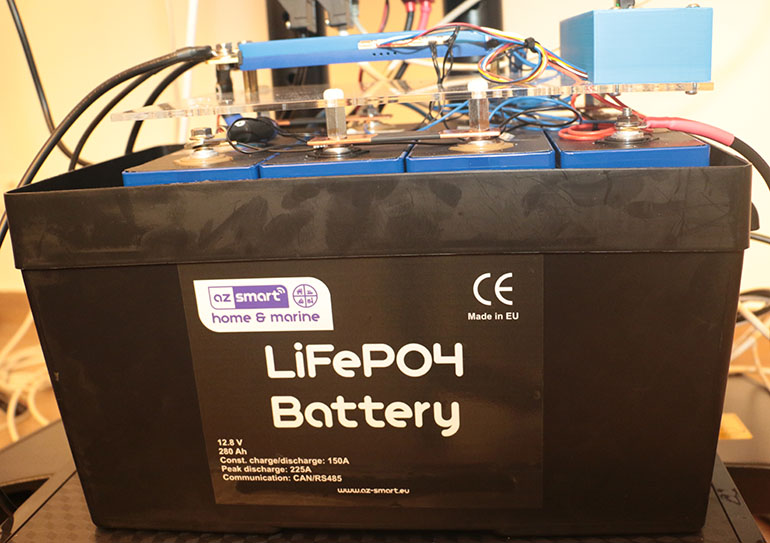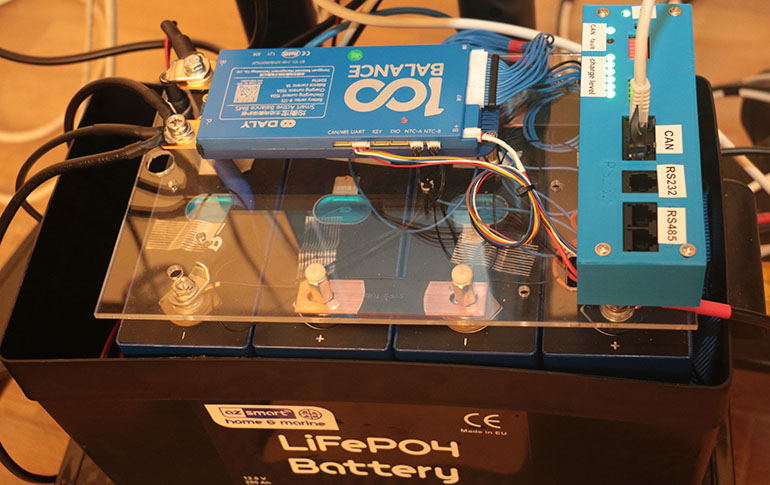Safety:
LiFePO4 batteries are less prone to overheating and fires than Li-ion batteries. This is because LiFePO4 chemistry is more stable and less susceptible to temperature changes. While a burning Li-ion battery is virtually inextinguishable, a LiFePO4 battery can be extinguished.
Longer Lifespan:
LiFePO4 batteries generally withstand more charge cycles (3000-4000 cycles or more), whereas Li-ion batteries typically endure 500-1000 cycles.
Deep Discharge and Charging:
LiFePO4 batteries handle deep discharges better and are not easily damaged if fully discharged. Additionally, LiFePO4 batteries can be charged faster.
Temperature Tolerance:
LiFePO4 batteries perform better over a wider temperature range. They operate more effectively in both cold and hot environments compared to Li-ion batteries.
Environmentally Friendly:
iFePO4 batteries are less toxic and more environmentally friendly since they do not contain heavy metals like cobalt or nickel found in many Li-ion batteries.
Energy Efficiency:
LiFePO4 batteries are more energy-efficient, meaning less energy is lost as heat, and more energy is available for useful work.
Weight and Size:
Although LiFePO4 batteries are generally heavier and larger than Li-ion batteries, improvements in energy density (energy per weight and volume) are making these differences smaller.
Overall, LiFePO4 batteries offer numerous advantages in terms of safety, lifespan, temperature tolerance, and environmental protection, though they have lower energy density than traditional Li-ion batteries.
LiFePO4 (lithium iron phosphate) batteries offer several advantages over traditional lead-acid batteries in terms of both performance and longevity. Here are the key benefits:
Longer lifespan
LiFePO4: Can endure 2000–5000 charging cycles, greatly extending its lifespan. Some models can last up to 10-15 years.
Lead-acid: Typically lasts for 300-500 cycles, with a lifespan of about 3-5 years.
Higher energy density
LiFePO4 batteries provide more energy storage capacity in a smaller and lighter form, making them more compact and lighter than lead-acid batteries.
Higher efficiency
LiFePO4 batteries have an efficiency of around 95-98%, whereas lead-acid batteries typically offer only 70-85% efficiency. This means LiFePO4 batteries charge faster and lose less energy during charging.
Safety and stability
The chemistry of LiFePO4 batteries is much more stable and less prone to overheating or catching fire compared to other lithium batteries (e.g., Li-ion) and lead-acid batteries. They also have better thermal resistance.
More environmentally friendly
Lead-acid batteries contain lead and sulfuric acid, which can pose environmental risks if not disposed of properly. LiFePO4 batteries, on the other hand, contain fewer toxic materials, making them more eco-friendly.
Protection against deep discharge
LiFePO4 batteries are more resilient to deep discharges without suffering significant damage, whereas lead-acid batteries can experience a shortened lifespan if frequently deep discharged.
Wider operating temperature range
LiFePO4 batteries perform better in extreme temperatures, especially in cold conditions where lead-acid batteries often lose efficiency.
Faster charging
LiFePO4 batteries can charge much faster, often reaching full capacity in 1-2 hours, whereas lead-acid batteries may take several hours.
Overall, LiFePO4 batteries are a superior choice over traditional lead-acid batteries due to their longer lifespan, lighter weight, greater safety, and higher efficiency, although the initial cost may be higher.
The batteries we offer consist of sealed cells that do not require maintenance. BMS (Battery Management System) measures temperature, voltage per cell and total current. In case of overheating, overload, overcharging or short circuit, it automatically intervenes and switches off the cells. They can be connected in parallel and each battery has active cell equalization. Batteries can communicate with the inverter, charger via CAN bus or ModBUS (RS485). The battery is compatible with the Victron Energy system and can communicate via the VE Can protocol. LiFePO4 batteries cannot be installed Plug'n Play instead of traditional lead batteries. The shore charger must support the LiFePO4 battery charging method. The engine alternator must NOT be connected directly to the LiFePO4 batteries, as this may cause the alternator to fail. Between the alternator and the battery it is necessary to install a DC-DC charger, eg Victron Orion or Renogy DC-DC charger.
Batteries are available with a nominal voltage of 12 and 24V, the basic configuration in both cases allows a maximum charge and discharge current of 150A, in case of individual needs it can be 200A, 250A and 300A.
Batteries:
- 12.8V (nominal 12V) 280 Ah, 4 cells
- 12.8V (nominal 12V) 304 Ah, 4 cells
- 25.6V (nominal 24V) 280 Ah, 8 cells
- 25.6.8V (nominal 24V) 304 Ah, 8 cells
Cell dimensions:
280 Ah: (W x D x H) 173.6±0.3mm x 72.0±1.0mm x 204.8±0.5mm
304 Ah: (W x D x H) 173.6±0.3mm x 72.0±1.0mm x 208.8±0.5mm
Warranty 5 years.







